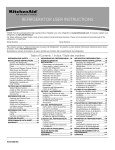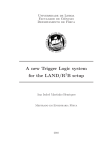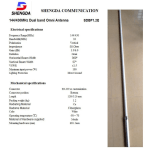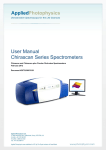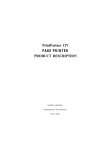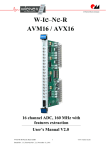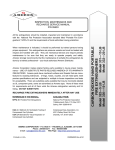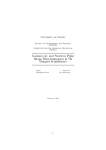Download Manual Preamplifier SP883d - Nuclear and Particle Physics
Transcript
Basel LNP, a discrete Preamplifier for VPT/T (&APD) readout, model SP883d, Preliminary Version Manual Preamplifier SP883d Preliminary user manual/datasheet for the low power/low noise (LNP) charge preamplifier for APD&VPT/T readout in Panda EMC proto 192 Author: Werner Erni Experimental Particle Physics Group of Prof. Dr. Bernd Krusche in collaboration with Dr. Irakli Keshelashvili, Michael Steinacher, Universität Basel, CH; Universität Bochum, D; GSI Darmstadt, D; KVI Groningen, NL Status: Preliminary Draft Version 0.5.8 is available on http://panda-wiki.gsi.de/cgi-bin/view/DCS/SupportedHardware Revision History Version 0.1; December 23, 2010/Werner Erni Version 0.6.4; July 17, 2012/Werner Erni Photo: Preamp SP883d. Round HV-divider soldered to Hamamatsu VPT Main Features of low noise/low power charge preamplifier model SP883d • Low noise (high resolution) relative to power consumption • For Vacuum Photo Triodes (VPT), Photo Tetrodes (VPTT) & APD • Completely analog electronics • Single ended, AC-coupled 50Ω positive signal output • Integrated low power HV-Divider(Bleeder/Bias) for up to 1,5kV. Space saving, significant less cables (1 instead of 3)! • Integrated low & high voltage power supply filter • Reduced dimensions (length 28mm), short “stamp” format • Two separate boards (PCB), without PCB-connectors • Low cost with components of the shelf • Operation at -25°C, radiation and magnetic fields • Fast rise time (<20ns) for energy & time measurements • Single range: reduces ADC-channels (cost), power, space • Driver for signal transmissions integrated (drives 50 Ohm standard coaxial cables) • Easy operation: Power supplies (LV+HV) in -> Signal out SP883d_Manual_Preamp page 1 of 55 Physics Uni Basel, CH-4056 Basel Basel LNP, a discrete Preamplifier for VPT/T (&APD) readout, model SP883d, Preliminary Version Table of Contents (F9 to refresh) Manual/Datasheet Preamplifier SP883d ................................................. 1 Precautions ................................................................. Concept of the Panda Electromagnetic Calorimeter EMC readout .......................... Introduction ................................................................. Panda EMC Forward Endcap Proto 192 (192 crystals, red marked part) ...................... Main Challenges .............................................................. Family of LNP preamplifiers ...................................................... 3 3 4 5 6 6 Photodetectors ......................................................................................... 8 a.) Hamamatsu Triode R11375MOD3 .............................................. b.) Hamamatsu Tetrode R11375MOD .............................................. c.) Hamamatsu APD S8664-1010 and S11048 (“rectangular”), datasheet available .............. d.) RIE Tetrode (VPTT) ......................................................... e.) Hamamatsu Triode R2148 (metal, short) .......................................... 8 8 8 8 8 Short Data type SP883d ........................................................................... 9 General remarks for operation .............................................................. 10 Power–up procedure .......................................................... 10 Application Hints for best operation .................................................... 11 Troubleshooting Guide .................................................... Comparing noise measurement results ............................................ Noise measurement setup ...................................................... Example (Noise measured with shaper and oscilloscope) ............................... 12 12 13 14 Schematic diagram SP883d (for VPT/VPTT) ........................................ 15 Differences between the versions of SP883d_PS (VPT, VPTT, …) ......................... 15 Circuit/component function description ............................................. 17 Wiring & Assembling ............................................................................. 20 Differences between SP883d Prototypes and Serie –Version. ............................ Wiring for series-version: ....................................................... 1. Connecting/wiring of power supply .............................................. 2. Isolation ................................................................. 3. VPT/T connection .......................................................... 4. Assembling VPT/VPTT ...................................................... 5. Adapter-PCB for Dual APD/crystal .............................................. 20 20 21 21 21 22 24 Distribution of Power Supplies ............................................................. 31 HV ....................................................................... HV for Proto192 ............................................................. LV (+/-6V or +8/-2V) .......................................................... Option: +10V/-2V Operation ...................................................... 31 31 33 33 Pulse Processing ................................................................................... 34 Signal chain ................................................................. Spice Simulation .............................................................. Gain...................................................................... Dynamic Range ............................................................. Rate...................................................................... Pile-up .................................................................... Signal to Noise ratio .......................................................... Noise vs. Cooling vs. detector capacitance .......................................... Rise Time/Timing Information ................................................... Shaper .................................................................... Cable ..................................................................... ADC...................................................................... 34 34 35 35 35 35 36 37 37 38 38 41 Matching (single ended to differential signal conversion) ................. 41 Mechanics .............................................................................................. 43 Crystal & Alveoles ............................................................ 43 Test Setup (Recommended) .................................................................. 44 SP883d_Manual_Preamp page 2 of 55 Physics Uni Basel, CH-4056 Basel Basel LNP, a discrete Preamplifier for VPT/T (&APD) readout, model SP883d, Preliminary Version Reliability ................................................................................................ 45 Quality .................................................................... 45 Production tests ............................................................. 45 Radiation Hardness .......................................................... 45 Addendum .............................................................................................. 46 Experimental Setup........................................................... Beam Tests ................................................................ Distribution of Power consumption ................................................ Magnetic fields .............................................................. Results ................................................................... Energy resolution: Comparison of ASIC readout (prototype 16) & LNP readout (Proto60) ......... References................................................................. Options ................................................................... Overview LNP Preamplifier “ChAmp” (Charge amplifier) -Familiy (Evolution Chart) ............. Implementations ............................................................. Test Setup (SP903c) .......................................................... The Prototype SP883(c)d ...................................................... Glossary/Abbreviations ........................................................ Links ..................................................................... Thanks to .................................................................. 46 47 47 47 48 48 49 49 50 51 52 53 53 53 53 Precautions Electronic circuits can be damaged by Electrostatic Discharge, ESD. It is strongly recommended that all devices be handled with appropriate precautions. Failure to observe proper handling and installation procedures can cause damage. ESD damage can range from performance degradation to complete device failure, sudden or while operated. ESD is produced by walking on floors, through friction on isolating surfaces, shoes, clothes, etc. Basic methods are not to touch, use conductive ESD-bags to store and grounding strips when handling the device. Concept of the Panda Electromagnetic Calorimeter EMC readout The Low Noise / Low Power Charge Preamplifier (LNP “Basel”-Preamp) is a discrete charge preamplifier which has an excellent noise performance in combination with low power consumption. It is designed for the readout of Photodetectors for the Panda Electromagnetic Calorimeter (EMC). The Photodetectors (LAAPD, VPT, VPTT) are attached to the end face of the lead tungstate scintillating crystals (PWO-II) 3 which have a typical geometry of (200 x 20 x 20) mm . In comparison to a photomultiplier, theses photodetectors are working better in a strong magnetic field. Further, the vacuumphotodetectors as Vacuum-Photo-Triode (VPT) and the Vacuum-Photo-Tetrode (VPTT) are better for high radiation which occurs in the center of the forward endcap than the semiconductor device LAAPD. Therefore the barrel and the backward endcap of the EMC is equipped totally with LAAPDs and the forward endcap works with VPT/T’s and LAAPD’s dependent of the region. These devices act as photo detectors converting the scintillating light to an electrical charge. Then, the LNP-Preamp linearly converts the charge signal to a positive voltage pulse which is transmitted via a 50 Ohm line to the subsequent electronics. Since the complete EMC including the preamplifiers will be cooled to -25°C (to increase the light-yiel d of the PWO-II crystals), the power dissipation of the preamplifier has to be minimized. Low power dissipation leads to a smaller cooling unit and thinner cooling tubes; it also helps to achieve a uniform temperature distribution over the length of the crystals. The LNP-Preamp has a quiescent power consumption of 45 mW. The power dissipation is dependent on the event rate and the photon energy; at very high rates combined with the maximum photon energy, the power consumption is increased up to 90 mW. SP883d_Manual_Preamp page 3 of 55 Physics Uni Basel, CH-4056 Basel Basel LNP, a discrete Preamplifier for VPT/T (&APD) readout, model SP883d, Preliminary Version Introduction This LNP Preamplifier was built for applications where low noise and low power consumption is essential, as specially for the PbWO-crystal read-out of Panda Calorimeter at GSI, Darmstadt. Preamps with lower noise are available on the market but then with higher power consumption. The model SP883d is the latest version of a family of preamps originally designed for APD with a capacitiy of up to 500pF (f.e. two paralleled Hamamatsu S8664-1010 or S11048). The output is a positive low noise single ended 50Ω-signal, useable for energy and timing measurement. Therefore, no shaping is made on board, this must be done externally. The shaping time for energy measurement defines then the noise. While the signal/noise ratio with VPT is comparable to those with APD, the absolute signal and noise level is much lower and therefore the sensitivity is higher and all activity to prevent from noise must be even better. The influence of the noise from the preamplifier is proportionally higher in relativity to the vacuum photodetector with lower capacitance. The realized mechanical shape was chosen, to fit into the foreseen limited space for the Proto 192 (crystals) for the Panda FW endcap also with the longer glass-tubes from Hamamatsu. A round PCB shape was not possible for this space. The Preamp is foreseen to work at -25°C, but can al so be operated at higher temperatures, but with more noise (around +20% @ 20°C). Vacuum Photo Tubes are not highly temperature sensitive in comparison to the APD’s and isolate the Preamp termally from the crystal. With APD’s an additional temperature barrier or distance is necessary. The originally concept was built for a range of around 10MeV to 10GeV, but lower energies may be detected with a good measured setup. A low power HV-divider circuit for up to 1.5kV is also implemented. This low power circuit is a new method, because manufacturers of tubes recommends higher power consuming bleeder circuits. Hence it was possible to implement the divider on the preamp itself in the cooled - and therefore power loss critical sector- of the detector. This innovative concept reduces not only problematic temperature gradients to the photodetector and the crystals, but also the amount of HV-cables and therefore space and cooling losses. To implement the additional HV-circuit on the reduced area, the preamp was split into two PCB’s. In addition, it prevents from leakage currents to the input of the amplifier stage. Each type of photodetector needs his very own typical divider-circuit which is placed on one of the two boards. As tradeoff this results in slightly more noise. A precise power-on-point HV-generation onboard (“active base”) is not foreseen due to additional heat generation and the magnetic fields at that point. The use of unshielded magnetic components as inductors for power conversion and filtering is problematic. The leave out of connectors reduces material, volume, costs and weight and increases reliability. The preamp is connected to the next signal chain stage (either a shaper or a distribution panel) via short wires/cables/PCB and the connection to the photodetectors is also possible with short distance. The preamplifier is made of commercial standard low cost components of the shelf. An adapted version for use with APD’s is also available. The appropriate HV-circuit (filter) which works also as an interconnection to the APD’s is designed for two preamps/crystal of either type SP883d (18x28mm) or SP883a02 (18x48mm). This version has reduced series filter resistance to reduce the voltage drop at high rates. SP883d_Manual_Preamp page 4 of 55 Physics Uni Basel, CH-4056 Basel Basel LNP, a discrete Preamplifier for VPT/T (&APD) readout, model SP883d, Preliminary Version Panda EMC Barrel Proto60 (Picture Tobias Eissner) Uni Basel, IPN Orsay, Uni Giessen, etc. Panda EMC Forward Endcap Proto 192 (192 crystals, red marked part) Uni Basel, Uni Bochum, etc. http://panda-wiki.gsi.de/cgi-bin/view/EMC/ForwardEndcapEMC SP883d_Manual_Preamp page 5 of 55 Physics Uni Basel, CH-4056 Basel Basel LNP, a discrete Preamplifier for VPT/T (&APD) readout, model SP883d, Preliminary Version Main tasks/challenges • • • • • • • • Low noise at low power Signal transmission/output voltage/dynamic range Low overall cost/easy operation Energy and time measurement (no onboard-shaper) Max. Rate/pile-up Integration of a low power loss HV bleeder for operation in cooled areas Mechanical integration in limited space with onboard-HV Flexible design for different photodetectors APD/VPT/VPTT Family of LNP preamplifiers Since the APD-Version of the preamplifier was developped years ago and many measurements and tests were performed with it, refer to the datasheet SP883a02 or the TDR 2008 for specific data for use with APD’s. The actual version SP883d and the new types of vacuumphotodetectors were developed in 2010. Therefore they are still in test phase. Below an overview is shown: Model/Type No. SP883a Photodetector APD 10x10mm max. HV 500V SP883a01 SP883a02 SP883a02_1000V VPT short glass APD 10x10mm APD rectangular 1000V 500V 1000V SP883a03 APD rectangular 1000V SP883b SP883c APD 10x10mm VPT metal Hamamatsu 500V 1000V SP883(c)d SP883d SP883d_VPT(Ham) 1500V 1500V Description APD single channel family, 18x48mm, PCB: 0.8mm With round shaped filter PCB, soldered to tube compensation for up to 500pF With 1000V capacitors (Bias APD: ca. 650V) compensation for up to 500pF Low Gain, Low Bias HV filter resistor (150k), 100pF* compensat. quad channel (Proto60), 46x46mm without onboard HV divider, PCB: 4-Layer 1.6mm Prototyp: Umbau von SP883c auf Funktion v. “d“ Combi family (APD/VPT/VPTT), “stamp-format”, 2 PCB à 18x28mm, with onboard HV-Divider with onboard HV-Divider for VPT (750V) VPT glass, 1500V Hamamatsu SP883d_VPTT(Ham) Tetrode glass, 1500V with onboard HV-Divider for VPTT (750V) Hamamatsu SP883d_VPTT(RIE) RIE 1500V with onboard HV-Divider for RIE VPTT’s (1200V) SP883d_APD APD rectangular 450V 3MΩ-filter for 2 APD-Bias, w. 100pF* compensat. SP883e VPT/T 1000V Smaller, higher rate 100pF*-Compensation value is implemented (designed for VPT/T). This may cause to a little slower rise time, but better stability, specially at lower temperature. Also used for LowGain-APD (SP883a03). Standard value for APD with +/-6V is 47pF, for +8V/-2V 100pF. Note: SP 883 d 01 _APD type number key, Example SP883d01_APD: Schematic Plan Projectnumber Electronics Lab Physics Basel for the Panda EMC Preamp Model/Type Revision/Version 1 variante/adaption SP883d_Manual_Preamp page 6 of 55 Physics Uni Basel, CH-4056 Basel Basel LNP, a discrete Preamplifier for VPT/T (&APD) readout, model SP883d, Preliminary Version For use with Photodetectors, f.e. for following devices: Model Hamamatsu LA APD S8664-1010 Hamamatsu LA APD S11048 Hamamatsu LA APD Low capacity (not radiation hard) Hamamatsu Photo-Triode R2148, short glass (Proto) Hamamatsu Photo-Triode R2148MOD, short metal Type APD, ca. 450V APD, ca. 450V APD, ca. 630V VPT, 750V VPT, 750V Hamamatsu Photo-Triode R11375 MOD3 Hamamatsu Photo-Tetrode R11375 MOD Research Institute Electron (RIE, St. Petersburg) PhotoTetrode RIE FEU-189 (21mm), IHEP/MELZ RIE FEU-190 (25mm), IHEP/MELZ Other: Photonis, ET, … VPT, 750V VPTT, 750V VPTT, 1200V Notes 270pF, square 13.7x14.5mm(10x10) 270pF, rectangular 9x18mm(6.8x14) …pF, rect. 9x18mm (6.8x14) (shielded “Kovar” FeNiCo can), ∅24x 30mm ∅24x 40+10mm ∅24x 40+10mm ∅22x 32+…mm VPT VPT “CMS” Prototype Photo: SP883d Glue candidates (silicones): Dow Corning RTV 3145 Elastosil RT 601 SP883d_Manual_Preamp page 7 of 55 Physics Uni Basel, CH-4056 Basel Basel LNP, a discrete Preamplifier for VPT/T (&APD) readout, model SP883d, Preliminary Version Photodetectors a.) Hamamatsu Triode R11375MOD3 b.) Hamamatsu Tetrode R11375MOD Hamamatsu Pin numbers (new version) c.) Hamamatsu LAAPD S8664-1010 (“old”); S11048 (“new rectangular”) d.) RIE Tetrode (VPTT) Thanks to Michael Leyhe, RUB, 29.1.2010 VPTT (RIE) with silicone Isolation and protection VPTT (RIE) without silicone potting e.) Hamamatsu Triode R2148 (metal, short) Photo: R2148MOD connected to LNP Version SP883c SP883d_Manual_Preamp page 8 of 55 Physics Uni Basel, CH-4056 Basel Basel LNP, a discrete Preamplifier for VPT/T (&APD) readout, model SP883d, Preliminary Version Short Data for type SP883d Max. Bias Voltage Power Supply, floating Power Supply for increased output voltage range (limits rate!) Quiescent power consumption Power consumption (depending on rate and energy) Max. single pulse input charge Max. 500 kHz burst event rate input charge Max. continous 500kHz event rate input charge Output Signal, Sensitivity Output Signal, Sensitivity Max. output voltage (with +6/-6V power supply) Max. output voltage (with +6/-6V power supply) Max. output voltage (with +8/-2V power supply) Output impedance Rise Time (with input load/detector capacitance 22pF) Feedback time constant Input Load/detector capacitance +1500VDC (+450V for APD) max. +/-6V, +6mA/-1.5mA +8V/-2V (max.+10V/-2V) 45mW 90mW with 50Ω load 4pC 0.3pC 8pC ca. +0.5V/pC@50Ω ca. +1V/pC ohne Last >+2.5V@50Ω >+5V@1kΩ >+3.5V@50Ω 50Ω ca. 15…<20ns 25µs 0…300pF (SP883a02 80…500pF) Typical noise performance with RIE-Tetrode/1100V (Ti=250ns, Td=2µs) with Cd=270pF (Ti=250ns, Td=2µs) *Typical noise performance @ Cd=22pF (shaping 650ns) *Typical noise performance @ Cd=22pF (shaping 200ns) *Noise floor (shaping 200ns) *Practical energy range/Dynamic Range (@VPT: 16aC/MeV) ca.625e-RMS(1mVRMS)@+25°C ca.2500e-RMS@+25°C ENC=235 e-RMS @ –25 ºC ENC=450/300e-RMS @-25°C 3MeV RMS 6MeV…10GeV(250GeV)/1650 Typical noise performance with APD-Preamp SP883a02 APD Hamamatsu S8664-1010 (Ti=250ns, Td=2µs) Cd = 270 pF (Ti=250ns, Td=2µs) Cd = 82 pF (Ti=250ns, Td=2µs) ca.2100e-RMS@+25°C ENC = 1’700 e-RMS @ –25 ºC ENC = 1’250 e-RMS @ –25 ºC ENC = 510 e-RMS @ –25 ºC Shaping (Integration 250 ns /Diff. 2 µs: Measured Noise RMS Shaping 250 ns /250 ns Measured Noise RMS @270 pF: 2600e (@82pF: 900e) @270 pF: 2870e (@82pF: 1360e) Operating Temperature Humidity Dimension without wires Weight -25°C …70°C non condensating 18 x 28 x ca. 10mm >4g *measured on a modified single board prototype, by Michael Steinacher, 2008, Uni Basel. see datasheet SP883a01. Depends on different conditions, has to be verified in every application. Note: Oscilloscope measured value of 1 mV rms is around 625 electrons rms [electrons rms = µV/1,6]. SP883d_Manual_Preamp page 9 of 55 Physics Uni Basel, CH-4056 Basel Basel LNP, a discrete Preamplifier for VPT/T (&APD) readout, model SP883d, Preliminary Version General remarks for operation • • • • • • • • • • • • • • • • • • • • • • • • • • This Preamplifier was designed to work directly with the VPT or VPTT from RIE or Hamamatsu, but can also be adopted for other detectors and mechanical designs. As a photon energy of 100 MeV corresponds to a pulse peak of only 3.2 mV the subsequent electronics has also to be designed with low noise performance. To save space, cables are soldered directly onto the PCB. The use of an AC coupled device has many advantages, as to prevent common mode GND-level problems and crosstalk, but might also cause problems, because the shift of the signal baseline on the trigger branch side at high and fast changing rates. To prevent this, the signal output is terminated with 50Ω. The transmission line (PCB/shielded flat or coaxial cable) and the input of the following shaping amplifier must have also 50Ω impedance. The output signal is about 0.5V/pC when terminated with 50Ω (1V/pC unterminated). The peak output is an optimised voltage for ADC-Inputs (2V). The Preamp has one single ended output and is therefore optimized for ADC‘s with 2.5V Inputs (f.e. Wiener, Struck, CAEN, etc.). The signal must be measured relative to its proper ground, as it is widely used in critical signal processing. Baseline restoring with shaper. Ref.: E. Kowalski “Nuclear Electronics”, Springer-Verlag, p.106ff, 163 Prevent the preamp from electrostatic discharge (ESD), specially if the input is open (no VPT). Do not touch the boards because of creepage currents through salts from hands.. Floating power supply +/-6V, f.e. from a NIM-Chassis, the Basel model SP903b or a laboratory power supply (alternatively +/-5V). Floating HV low noise power supply (often a linear regulated HV power supply as the Fluke 341A). The filter-circuit of the preamplifier is designed for positive HV, Max. voltage is +1500VDC The voltage divider is placed on the preamplifier with only one HV-wire to save space and thermal conductivity. The power consumption of the voltage divider is significantly lower than the original circuits recommended from manufacturers, to make an on-board divider possible for cooled experiments. The power consumption of the voltage divider is in competition with fewer cables/copper. A good 6-side shielding around the preamp must be provided to insure low noise operation. Connect the case shield to the preamp via mounting holes, cable shields, Supply-GND. To proceed low noise measurements all coaxial cables and connectors must be in perfect condition. Prefere BNC before Lemo for low level analog signals. Warm-up the instruments. The short rise time allows precise timing measurements (timing resolution down to under 2ns possible, depending on read-out NP0 Ceramic Capacitors are used in the critical signal path, X5R/X7R with appropriate temperature behaviour are used for decoupling and power supply filtering. Test pulse coupling via a 1 pF Capacitor For use in high magnetic fields (tested up to 1.2T, but more expected) The rectangular APD with smaller capacitance and higher bias-voltage (typ.+630V) is also possible, but they are less radiation hard. Radiation Hardness is not yet fully tested. Implementation of suitable technology: CMOS+JFET The "long tail" of the LNP-Preamp output results from the feedback-network (1 pF//25Meg). The resulting 25 us is a compromise between low-noise performance and high-rate capability (pile-up). In principle this time-constant can be reduced, but you will get more noise. The shaper after the preamplifier can reduce this fall-time without any problems as long as the preamp doesn't go to saturation due to pile-up. The "undershoot" of the signal results from the AC-coupling of the output. Proper adopting of the signsal by the shaper can solve this. Power–up procedure Low Voltage power supply (+/-6V) should switched on first, before the HV and therefore with signal. Normal operation is given with a supply current of around 6mA on +6V and 1mA on -6V. A higher supply current indicates ringing or defect. Power up the HV via a ramp. If not, the ISEG HV-supply will switch off, because of relatively high current from loading the capacitors. SP883d_Manual_Preamp page 10 of 55 Physics Uni Basel, CH-4056 Basel Basel LNP, a discrete Preamplifier for VPT/T (&APD) readout, model SP883d, Preliminary Version Application Hints for best operation To get lowest possible noise it is essential to take extremely care to the overall-construction. Example: A real measured noise level is: with good ground-connection 2.9mV (Ground via case and Power Supply), with a poor GND (only via coax-shield) 4.3mV. That’s a difference of roughly +50%! So: The best way of using the LNP charge-preamp (SP883x) in an experimental setup is as following: - Connect the photodetector (APD, VPT/T) with a short ( lmax = 100 mm) coax-cable to the LNP preamp; or even better connect directly to the LNP preamp. - Leave the photodetector electrically floating; this means that the APD-ground comes from the LNP preamp via the outer shield of the short coax-cable. - Place the photodetector/coax-cable/LNP preamp in a electrically floating metallic (e.g. Alu) box which is grounded by the output of the LNP preamp (e.g. by a BNC wall-feed-trough). - For the photodetector HV-bias voltage use a low noise floating supply; use a shielded SHV or MHV cable to connect the bias-voltage to the metallic box via SHV/MHV feed-through (this interconnects the ground of the biassupply and the output of the LNP preamp). - Use a low noise (linear regulated) and floating power supply for the LV-supply of the LNP preamp (+/-6 V or +8 V/2 V). - The reference ground of the metallic-box is coming via the 50 Ohm BNC cable connecting the LNP preamp output to the oscilloscope/DAQ. The oscilloscope/DAQ has to be connected to earth/ground. In general it is very important that only one ground (oscilloscope/DAQ) is connected to the metallic-box, otherwise nasty ground-loops will interfere with the very sensitive signals. Noise (Datasheet SP883a01) To reach the required low detection threshold of only several MeV, the noise performance of the preamplifier is crucial. The VPTs have an outside diameter of 25 mm and a typical photocathode with a 2 diameter of 18.5 mm, resulting in an active area of circa 268 mm . Compared to the active area of the 2 LAAPD (100 mm ) this is an increase of a factor 2.7. The VPT anode capacitance is around 22 pF which is more than ten times lower than the capacitance of the LAAPD; this results in a much lower noise from the LNP-Preamp. Thus, the shielded cable between the VPT and the LNP-Preamp has a significant impact on the total detector capacitance; it must be kept as short as possible. The dark current of the VPT is significant lower than the one from the LAAPD; 1 nA compared to 50 nA, both measured at a room temperature. On the other hand the quantum efficiency (QE) of the VPT is only about 20%, compared to 70% of the LAAPD. Further the internal gain (M) of the VPT is only around ten, which is five times lower than the LAAPD. The noise floor of the LNP-Preamp at –25°C loaded w ith an input capacitance of 22 pF, has a typical equal noise charge (ENC) of 235 e RMS. This is measured with an ORTEC 450 shaping filter/amplifier with a peaking-time of 650 ns. Because the VPT has almost no dark current the noise is not increased due to the leakage current of that photo detector. Assuming 100 photons/MeV at the end face of the cooled (–25°C) PWO-II crystal would result in 43 photons/MeV on the active area of the VPT. This is coming from the fill factor of 40%: VPT active area of 2 2 268 mm with respect to an end face area of about 625 mm . Since the end face not covered by the VPT will be masked by highly reflective material, we assume 50 photons/MeV on the VPT. By applying the QE and the internal gain of the VPT, a primary photon with the energy of 1 MeV induces an input charge of 16 aC (100 e ) to the preamplifier. So an ENC of 235 e RMS corresponds to an energy noise level of about 2.4 MeVRMS. This is almost the same energy noise level as achieved under the same conditions in the barrel with the LAAPD readout (2 MeVRMS). At the same photon energy, the signal from LNP-Preamp connected to a VPT is a factor of nine smaller, but also the noise is a factor of more than seven smaller compared with the LAAPD. That's why the signal to noise is in the same order when using a VPT or an LAAPD for the readout of a PWO-II crystal. All these numbers above are related to the VPT type RIE-FEU-190 used in the CMS ECAL. By using new VPT, the energy noise level will be reduced remarkable. This may also be necessary, because the noise level is increased as the shaping time is decreased. Shorter shaping times are mandatory to cope with the expected high event rates in the endcap. By decreasing the peaking-time from 650 ns (reference values) to 200 ns the noise level is raised by around 25%. So the noise floor with the more realistic shaping with a peaking-time of 200 ns corresponds to 3 MeVRMS. SP883d_Manual_Preamp page 11 of 55 Physics Uni Basel, CH-4056 Basel Basel LNP, a discrete Preamplifier for VPT/T (&APD) readout, model SP883d, Preliminary Version Troubleshooting Guide Source/Effect Typical source action General Noise pick-up wires to detector Connect as close as possible to tube, f.e. VPTT (RIE) with socket/without silicone Low noise floating power supply, well filtered, shielded cables (connect to GND on LNP side) Distance, shielding Noise conducted Noise radiated Noise exceeded Hum, noise Ca. 1 kHz rolling Cut-off HV HV changes noise Crosstalk/induction Shadow pulses Phantom pulses Uncorrelated signals “Firework” of pulses “Spratzen” Afterpulses (duration 20 …100ns) Afterpulses (0.1…10us) Noise typ. 100kHz Noise factor 2 rms noise value Rate dependency noise Unlinearity Microphony EMC Magnetic field Magnetic field Electric field Electrostatic damage Ambient Microphony Humidity/moisture Temperature Creep currents Spontaneous avalanche Spurious pulses Defects photocathode Arcing Switchmode Power Supply, motors, vacuum pumps, cooling, etc. Switchmode Power Supply, VMEcrates, Digital electronics, PC Ground loop ? Scope measurements HV current limit ISEG HV CAN Bus ISEG HV CAN Bus Monitors, oscilloscopes, PC’s Reflections from signal transmission Dielectric absorption/leaks in capacitors?/stray current on PCB? Microphony of tube/ceramic capacitor Moving cables Schrotrauschen/Shot noise multiple separate HV Power supplies Luminous reactions of electrodes due to electron bombardment Ionization of residual gas traces Light leak from ambient noise of oscilloscope input amplifier, display +shaper Mismatched Impedance High resistance HV-Divider Ceramic capacitors changes volume during voltage changes Increase shaping time (tradeoff: pile-up) Only floating power supplies, starpoint ground Use (Struck) VME-ADC Ramp-up HV Ignore result while traffic on CAN Bus Ignore result while traffic on CAN Bus Distance, short shielded cables Mismatched 50 ohm termination Avoid vibration use 1HV with HV-Divider (“Bleeder” circuit) Improve HV-Isolation, cleaning PCB/cables Blanking if systematic/time correlated Blanking if systematic/time correlated Cover light tight Calculate difference Use correct termination (50ohm) use histogram mode scope for rms Lower resistance HV-Divider Warm-up Add capacitor to divider Coupling via PCB Stray fields (trafo, motor, pump) magnets FL-ballast, Switchmode PS Triboelectricity, touching Shield Shielded tube (f.e. Hamamatsu R2148) 6-side shield Conductive packaging, don’t touch Sound, vibration, shock Cold-warm cycles/bedewing Silence, mech. decoupling drying Cooling for noise reduction don’t touch preamp & photodetector Dust/grease/salt (from hands) Myon Light HV contamination With crystals Do not operate & wait after exposure Isolate preamp Comparing noise measurement results To get comparable noise measurement results, take care of following points : • Measure V rms (if Vpp on oscilloscope divide by 9), standard deviation • Photodetector : Capacity and gain • Crystal : Light yield, wrapping, glue • Subtract noise floor of equipment (measure test setup without preamp) • Calibrate signal chain with 1V signal pulse (or LED-Pulser or Gain of photodetector) • Multiply with gain of shaper • Temperature : Decide cooled at -25°C or at room te mperature • Grounding of preamp (if only via signal coax) multiply with a factor of around 1,5 • Shielding: 5/6-side metal, neighbourhood (FL-lamp, PC, VME, cooler, pump, etc.) SP883d_Manual_Preamp page 12 of 55 Physics Uni Basel, CH-4056 Basel Basel LNP, a discrete Preamplifier for VPT/T (&APD) readout, model SP883d, Preliminary Version Noise measurement setup 2 2 Noise R.M.S.=SQRT [(measured value) -(noise floor) ] Noise p-p viewed on the oscilloscope is approximately 9 times higher than the real rms-value. Q[pC]xU[mVrms]/10/1.6E-19=Noise [electrons] z.B. Noise in mV Std.Dev. x 1000/1.6= electrons Measurements taken with approx. peaking time of 650ns (Ti=250ns, Td=2µs) Similar test results are taken with peak sensing ADC (see test setup SP903c below) SP883d_Manual_Preamp page 13 of 55 Physics Uni Basel, CH-4056 Basel Basel LNP, a discrete Preamplifier for VPT/T (&APD) readout, model SP883d, Preliminary Version Example (Noise measured with shaper and oscilloscope) Source of the noise Left: oscilloscope input: 0.2mV rms Middle: measurement setup: 0.5mV rms Right: with amplifier +270pF: 2.7mV rms Method: SP883d_Manual_Preamp page 14 of 55 Physics Uni Basel, CH-4056 Basel Basel LNP, a discrete Preamplifier for VPT/T (&APD) readout, model SP883d, Preliminary Version Schematic diagram SP883d (for VPT/VPTT) Differences between the versions of SP883d_PS rectangular (VPT, VPTT, …) VPTT (RIE) VPTT (Ham.) VPT (Ham.) APD* R1a 3M3 10M 10M Open R1b 4M7 0 0 Open R2a 10M 10M 0 Open R2b 10M 10M 0 Open R3a 10M 10M 10M Open R3b 10M 10M 10M Open max U/ I 1200V/25uA 750V/15uA 750V/25uA Power consumption 30mW (20mW with 1000V) 12mW 20mW Note: all resistors 10M are 500V rated APD needs no divider, only filter is implemented SP883d_Manual_Preamp page 15 of 55 Physics Uni Basel, CH-4056 Basel Basel LNP, a discrete Preamplifier for VPT/T (&APD) readout, model SP883d, Preliminary Version Round Divider PCB, SP993d_HV for Hamamatsu VPT/T VPTT (Ham.) VPT (Ham.) R1a 10M 10M R1b - R2a 10M 0 R2b 10M 0 R3a 10M 10M R3b 10M 10M max U/ I 750V/15uA 750V/25uA Power consumption 12mW 20mW Note: all resistors 10M are 500V rated APD needs no divider, only filter is implemented R12 + R13 is each a single 22M/500V resistor instead of 2x10M in series to save space R1b is not implemented on the PCB to save space SP883d_Manual_Preamp page 16 of 55 Physics Uni Basel, CH-4056 Basel Basel LNP, a discrete Preamplifier for VPT/T (&APD) readout, model SP883d, Preliminary Version Circuit/component function description The circuits of initial versions are described in detail in the Panda TDR from June 2008, chapter 6.4.2. HV Divider (Bleeder) MiniMelf resistor Zener Diodes Low leakage diodes Ceramic Caps Tantal Caps significantly lower current/power (15...25µA) than in standard applications (around 0.5…1mA). Example for commercial low current type: Ortec 276L (200µA). Disadvantage is a higher sensitivity to EMC. Inrush current limit (tantal protection), filter Input protection device, transient overvoltage, polarity FET input protection X5R, X7R, C0G, NP0 for low temperature operating range Additional notes: Gain: lower gain = higher feedback capacity (+ change value of compensation capacitor) Dynamic range, higher positive power supply voltage (while lowering the negative), f.e. +8V/-2V Compensation: 100pF best for 0…100pF detector capacitance, min. 47pF for APD (270pF). A higher cap value slows down the pulse rise time. 100pF is also better when operated with +8V/-2V. A high Feedback resistor lowers the Johnson noise. Circuit description for VPT-preamp SP883a01 The AC-coupled input stage consists of a low noise J-FET of the NXP type BF862. It is specified with a typical input voltage noise density of 0.8 nV/sqrt(Hz) at 100 kHz and at room temperature. The J-FET input capacitance is 10 pF and the forward transductance is typically 30 mS at a drain-source current (IDS) of 5 mA. Along with the 470 Ohm AC-dominant drain resistor this transductance results in a typical AC-voltage gain of 14 for the J-FET input stage. The gate of the J-FET is protected against over voltages by two low leakage silicon diodes of the type BAS45AL. The input stage is followed by a broadband (300 MHz), fast (2'000 V/µs) and low power (±1 mA) current feedback operational amplifier of the type AD8011AR from the company Analog Devices. With its typical input voltage noise density of only 2 nV/sqrt(Hz) at 10 kHz, this amplifier suits well for such a low noise design. The proper frequency compensation is performed by the capacitor C13 (100 pF), in combination with R2 (10 Ohm); this leads to high frequency feedback to the inverting input of the operational amplifier. Overshoot and ringing can be efficiently suppressed and this compensation also prevents from oscillations when no VPT is connected. The output of the operational amplifier is DC-coupled via the feedback network (1 pF // 25 Meg Ohm) to gate of the J-FET. In parallel the output is AC-coupled via a 1 µF capacitor and a 47 Ohm series resistor to the output of the LNP-Preamp. Therefore the output voltage is divided by a factor of two if it is terminated with 50 Ohm. With a symmetrical supply voltage of ±6 V the output voltage can swing symmetrically between the positive and negative supply when high continuous event rates at high energies occurs. The LNP-Preamp draws a typical quiescent current of 6.3 mA from the +6 V supply and 1.2 mA from the –6 V supply; this leads to a total power consumption of only 45 mW. To set the 5 mA operating point of drain-source current through the J-FET, a gate voltage in a range of –0.2 V to –0.6 V (typically –0.3V, depending on the DC characteristics of the individual J-FET) has to be applied. This negative DC voltage is fed from the output of the operational amplifier via the 25 Meg Ohm resistor to the gate of the J-FET. The operating point (IDS=5 mA) is fixed by the well filtered DC voltage applied to the inverting input of the operational amplifier. This set point voltage is obtained by subtracting 2.5 V from the positive supply voltage (+6 V) by using a 2.5 V reference diode. So the same voltage drop of 2.5V must also be present over the total drain resistor of 503 Ohm (470 Ohm + 33 Ohm); this results in a stabilized DC drain current of 5 mA. The gate input of the J-FET is decoupled by a 4.7 nF high voltage capacitor. As the voltage drop over the LP filter for the VPT bias voltage has to be proven. At high rates in combination with high energies, a maximum current of 80 nA is flowing trough the VPT; mainly drawn from the dynode bias voltage supply. The planned series resistance of the LP filter is 40 Meg Ohm, resulting in a maximum voltage drop of 3.2 V. By using the typical gain sensitivity of 0.1% per volt of the VPT, this voltage drop corresponds to a maximum energy/rate error of –0.32%, which is acceptable. By reducing the series resistance of the LP filter, this energy/rate error could be further minimized. SP883d_Manual_Preamp page 17 of 55 Physics Uni Basel, CH-4056 Basel Basel LNP, a discrete Preamplifier for VPT/T (&APD) readout, model SP883d, Preliminary Version Circuit description APD-preamp SP883a02 Note to the text: 47pF is C15 not C13 (as shown in diagram) SP883d_Manual_Preamp page 18 of 55 Physics Uni Basel, CH-4056 Basel Basel LNP, a discrete Preamplifier for VPT/T (&APD) readout, model SP883d, Preliminary Version SP883a03 (APD-Pramp “LowGain”) PSpice Simulation The Lower Gain, with 2,7pF and 10MΩ Feedback, needs a different compensation. Instead of 47pF in SP883a02, 100pF is used to prevent oscillations. SP883d_Manual_Preamp page 19 of 55 Physics Uni Basel, CH-4056 Basel Basel LNP, a discrete Preamplifier for VPT/T (&APD) readout, model SP883d, Preliminary Version Wiring & Assembling Differences between SP883d Prototypes and Serie –Version. On Prototypes the LV-Filter and Pads for wires were on the thin PCB. For series this LV-circuit was moved to the thicker Amplifier-PCB (to enable the possibility to use it autonomously for APD’s). This increases also convenience for assembling. Wiring for series-version: Photo shows from top to down: 1. LV (red:+6V/black:GND/blue:-6V) 2. Signal (50 Ω coax), direct to the PCB or via a ITT-crimp part 3. HV (orange) and GND (black and optional yellow/green) Wiring of prototypes (for more convenience, see below): Connections VPTT+LNP SP883d Preamp SP883d 50R Coax RG178 with H.FL/U.FL out GND Anode (P) Dynode 2 Dynode 1 Kathode (GND) 2010 SP883d_Manual_Preamp SP883d_PS +HV -6V GND +6V GND Note: The GND of the Preamps is connected via the green/yellow litz-wire to the Power-Distribution-PCB. The shield (f.e. Aluminium-tube, d=25mm?) is also connected through the spring. 12 page 20 of 55 Physics Uni Basel, CH-4056 Basel Basel LNP, a discrete Preamplifier for VPT/T (&APD) readout, model SP883d, Preliminary Version 1. Connecting/wiring of power supply Because the Hamamatsu Triode/Tetrode R11375 MODx is significantly longer than previous versions (f.e. R2148), there is no space for connectors on the PCB. Therel ore, wires are soldered directly to the PCB. For assembling, the connectors will be mounted to the free end of the wires to connect to the power supply distribution board (and shaper). Use a floating output power supply (f.e. laboratory power supply Toellner 8735), SP903b from Basel, in some cases via a NIM-Crate Adapter or similar. The signal output should be wired with a 50 Ω coaxial cable (f.e. RG178). The 2 edition of the PCB (series) includes the additional possibility to solder a RG178 (∅1.8mm) coax-cable via ITT Cannon 055939-9039-AR6, available at Avnet Express or Newark, Part Number: 95F6346. For RG174 (∅2.8mm) via 055-939-9049FCD (Farnell: 121-5645). nd Another solution for connecting the coax shield is to solder the shortened shield of the partly dismanteled cable to the testpoints (keystone test points/compona.ch 220 202) and the inner conductor direct to the PCB: 2. Isolation There is high voltage on the board and the VPT/T. Isolate for up to 1.5 kV. Isolation can provided by shrinking tube or plastic tube. 3. VPT/T connection a.) Because the original semi flexible wires from Hamamatsu for the R11375 are not delivered with a socket and therefore not constructed for space-critical use. Because of the advice from the manufacturer, not to cut the pins and not to solder near the glass body, we preferred flexible litz-wires, but nevertheless it is not the optimum to save space in depth. Anyhow, due to the fact that the manufacturer cuts and solders the pins of the tubes close to the glass body (as they are delivered in fact), there is obviously a possibility to connect them in a much better way, but it has to be proceeded very carefully: Solder the pins for A(P) and K of the tube directly to the solder points of the preamp and bend the Dynode pin under no force at the glass (take the pressure off the glass with pliers) in a way, that a short wire can be soldered to the PCB. This is the most space-saving solution and also best for noise and stability. Ambient light tight protection also from rear side is absolutely necessary. If not, the tube will get damaged, when operated. SP883d_Manual_Preamp page 21 of 55 Physics Uni Basel, CH-4056 Basel Basel LNP, a discrete Preamplifier for VPT/T (&APD) readout, model SP883d, Preliminary Version 4. Assembling VPT/VPTT To achieve maximum flexibility in connecting the different photodetectors and mechanical construction, the two PCB’s of the preamp are delivered separately and have to be soldered together with four solder joints by the user. Several variants are possible: Variant 1: VPT soldered via litz wire Variant 2: VPT soldered to Preamp with a PCB-distance of 4mm (overall length: ca.78mm) Variant 3: VPT soldered close to Preamp with a PCB-distance of 10mm (overall length: ca.73mm), see Photos below Length of Preamp+R11375MOD Hamamatsu-Tubes: 73mm (with very carefull handling down to 70mm) if distance of PCB’s is 8-10mm (the glass exhaust is then overlapped by both Preamp-PCBs). If you choose a 4 mm PCB-distance, the overall length is then 5mm more, let’s say around >75mm. b.) The Hamamatsu R2148 and the RIE-Tetrodes (without silicone potting) are tubes with a pinsocket, which allows proper space-saving construction, f.e. via a socket or direct soldering to a disc-shaped interconnection-PCB. Left: comparison with/without silicone for RIE VPTT (Photo: Tomas Held, RUB) Right: VPTT (RIE) „bare“ (without silicone), 2 unused pins cutted Below: Universität Bochum (with Hamamatsu VPT/T) SP883d_Manual_Preamp page 22 of 55 Physics Uni Basel, CH-4056 Basel Basel LNP, a discrete Preamplifier for VPT/T (&APD) readout, model SP883d, Preliminary Version 2012 SP883d_Manual_Preamp page 23 of 55 Physics Uni Basel, CH-4056 Basel Basel LNP, a discrete Preamplifier for VPT/T (&APD) readout, model SP883d, Preliminary Version 4.a. Assembling VPT/VPTT, (new) Version with round HV New features to improve manufacturing and stability of Hamamatsu-tubes: • Round HV-PCB for Hamamatsu VPT or VPTT (RIE has different Pin configuration) • alternative HV-Connector Molex Spox (coded, locked) for HV connection (cut one edge) 1. 2. 3. 4. 5. 6. Abrade 1mm of PCB from Preamplifier-PCB carefully or mount the PCB transversal Solder in wires and Preamp-PCB justified into the round HV-PCB Solder HV-PCB to the VPT/T Glue PCB with small amount of non-corrosive silicone (as Dow Corning 3145 RTV) o the VPT/T 60mm shrinking tube Ø=24 mm onto the tube with HV-PCB or kapton tape to isolate the HV Wrap around 78mm self adhesive Alu-foil (sized 50mm or even better more, f.e. Tesa 50575) Example, see also: http://www.bonner.rice.edu/~jhzhou/up_pvpd/construction.html SP883d_Manual_Preamp page 24 of 55 Physics Uni Basel, CH-4056 Basel Basel LNP, a discrete Preamplifier for VPT/T (&APD) readout, model SP883d, Preliminary Version 5. Adapter-PCB for Dual APD/crystal For “short” preamplifier SP883d (might be usefull also for “long” version SP883a02) An additional ca. 18x18x1.6mm (depends on capsule), double-sided PCB was built. Features: • Protects the APD-Pins when mounting/dismounting from the crystals • Planar mounting of the APD-frontsurface (equalize differences through mounting aid, then solder and glue it to the PCB). • Holds the two preamplifiers to the capsule • Holds HV-Filter and Connector for APD • Connection and filtering for both HV’s th • GND-Plane of Dual APD-PCB is the 6 side of the electromagnetic shield! • Could be soldered to copper tube (via two 2mm holes) • Temperature shield (decoupling)/radiation barrier (similar as in Proto60) Glueing the APD to the PCB: maybe with an additional soft silicone sheet (removable?) Photo left: two “short” preamps SP883d+prototype DualAPD-PCB 20x20mm +“old” quadratic APD in a socket + cables Photo right: two “short” preamps SSP883d+dual APD adapter SP883d_APD 18x18mm, with a HV-Cable RG174 Mounting of SP883a02 (“long”) 5.a. New Capsule, with Preamp-holder An improved version with a Pramp-Holder made out of PEEK was designed an manufactured 2012. The (black) PEEK CF30 material was replaced by the natural PEEK because of the unneeded electrical conductivity through the carbon fibres. PEEK has better resistivity to radiation than POM, but is expensive and difficult to proceed. The separating divider bar is omitted in the latest version. The depth of the APD-„bed“ is slightly smaller to allow the APD to make full contact to the crystal. Photos: black PEEK CF30-Prototypes (not used) with modification and isolation, natural PEEK: latest version SP883d_Manual_Preamp page 25 of 55 Physics Uni Basel, CH-4056 Basel Basel LNP, a discrete Preamplifier for VPT/T (&APD) readout, model SP883d, Preliminary Version Operating Temperature The lower the temperature (typ. -25°C), the lower t he noise of the system. Please note, that for a constant internal APD-gain (M) the APD voltages must be decreased while decreasing the temperature. This is due to the temperature dependence of the gain vs. reverse voltage of the APD; see the graph of the APD data sheet. Each APD has to be controlled individually. Soldering the APD Solder the APD with high care: • Short time heating • Solder the APD with leaded • ESD-Protection Assembling 2012 for Proto192 SP883d_Manual_Preamp page 26 of 55 Physics Uni Basel, CH-4056 Basel Basel LNP, a discrete Preamplifier for VPT/T (&APD) readout, model SP883d, Preliminary Version Filter and decoupling The change of the values for the HV-filter (3M instead of 32M and 15nF instead of 4n7) was made to decrease rate dependency of the bias voltage HV (and therefore APD-Gain). Note: this reduction in bias voltage/gain dependency may result in a rate dependent temperature rise and therefore influence to the APD-Gain and crystal temperature! The resistors are now 3x 1M/150V (total of 450V) in a 0805 case because of lack of space for the 2x 500V resistors in the 1206 case. The reduced series filter resistance to reduce the bias voltage drop at high rates is partly compensated by a higher capacitor (15nF/500V in 1206 case, instead of 4,7nF). Additional capacitors on the external PCB might be usefull to keep low noise performance. Differences HV-Filter Adapter Compensation SP883a02 SP883a03 32 MΩ/4,7nF 150kΩ/4,7nF Filter on Preamp, not Filter on Preamp, Adapter not Adapter 47pF 100pF SP883d_APD 3 MΩ/15nF Filter on Adapter 100pF Detailed View of SP883d_APD to preamplifier 1 and 2 SP883d_Manual_Preamp page 27 of 55 Physics Uni Basel, CH-4056 Basel Basel LNP, a discrete Preamplifier for VPT/T (&APD) readout, model SP883d, Preliminary Version Schematic Diagram for APD (SP883d_APD+SP883d) SP883d_Manual_Preamp page 28 of 55 Physics Uni Basel, CH-4056 Basel Basel LNP, a discrete Preamplifier for VPT/T (&APD) readout, model SP883d, Preliminary Version 6. Capsule The capsule works as mechanical interface for the APD’s to the crystal. When mounting the APD’s into the capsule, take care because the capsule reaches around 0.2mm over the APD. Material: for Proto192 milled from POM, later for better radiation hardness PEEK is foreseen. Note: The HV is soldered directly to the PCB (placed around the center of the PCB between the preamps). To save cabling, only one HV is available for both APD’s. Therefore they must selected for gain-conformity. The cabling for LV (+/-6V) can also be reduced when both preamps are interconnected. The capsule and the Dual APD-PCB can be integrated optionally for high volume production as one unit made from Epoxy/FR4 as a “3D”-PCB. Also space can be saved that way. The two holes with 2mm diameter are connected to GND and can be used to mount the copper tube or similar. Connectors Contacting the preamps to the « Adapter-PCB » SP883d_APD is achieved by soldering the boards direct with a rigid wire or a 1 pin-connector (f.e. Farnell : 972-9151). For SP883a02 („long“) use Ø 0.5mm-rigid wire or 1 pin of the Fischer Elektronik MK LP 43. Note: Solder the pins on the component side, because on the APD/Capsule-side is no space for pins or solder joints. So cut the pins in a way that they do not reach out of the PCB. or alternatively with a connector : Board to Board, 8 contact, single row 2mm-pitch connectors (male 90° THT, female: SMD) Harwin Datamate L-Tek (f.e. Farnell: 177-6199/177-3791). Molex Series 55932, shrouded header, Part-No. 0559320810 SP883d_Manual_Preamp page 29 of 55 Physics Uni Basel, CH-4056 Basel Basel LNP, a discrete Preamplifier for VPT/T (&APD) readout, model SP883d, Preliminary Version Version “Low Gain” APD (for Proto192, 2012) SP883a03 is based on the the same PCB as Version SP883a02, but with some different components to reach lower gain (/2.5) and lower Filter resistance (Bias-HV dependency) for Proto192. Filter: R2 is now 50kOhm instead of 10MOhm and R3 is now 100kOhm instead of 22MOhm Gain: C13 is now 2.7pF instead of 1pF R11 is now 0 Ohm instead of 15MOhm Compensation: C15 is now 100pF instead of 47pF SP883d_Manual_Preamp page 30 of 55 Physics Uni Basel, CH-4056 Basel Basel LNP, a discrete Preamplifier for VPT/T (&APD) readout, model SP883d, Preliminary Version Distribution of Power Supplies The distribution of LV and HV can be done via a PCB (Design by Mario Fink, Bochum) Below: Model SP903a for Proto60 shown in pictures) or as “daisy chain” via loose wires. HV HV-Crates from ISEG, controlled by EPICS via CAN-Bus Left: Proto60 with HV; Right: Tests in Mainz; Tank with dry nitrogen gas (A), Vacuum pump (B), X-Y-Support (C), High Voltage Supply (D), Proto60 (E) HV for Proto192 APD: HV-Module ISEG EHS8 210p-F, +1kV/8mA, High Precision VPT/T: HV-Module ISEG EHS8 620p-F, +2kV/4mA 35 channels for VPT/T HV (sharing 1 HV among 4 channels) and 64 channels for APDs (sharing 1HV among 2 channels). Control Software is EPICS. Bus is CAN. Test beam at Bonn is preliminary scheduled end of July 2011. Delivery by the end of June to Bochum: 5 HV modules ISEG for VPT/T use 8 HV modules ISEG for APD use 2 crates ISEG with CAN-Bus for the modules SP883d_Manual_Preamp page 31 of 55 Physics Uni Basel, CH-4056 Basel Basel LNP, a discrete Preamplifier for VPT/T (&APD) readout, model SP883d, Preliminary Version Please note, that for a constant internal APD-gain (M) the APD voltages must be decreased if you decrease the temperature. This is due to the temperature dependence of the gain VS. reverse voltage of the APD; see the graph on page 2 on the attached S8664 APD data sheet. For further details contact Andrea Wilms. For the APDs we have measured, the reverse voltage had to be decreased about 10% to preserve the internal gain of M=50 between +25°C to -25°C. This was done by using a light-pulser system. If you have a light-pulser system, you can easily adjust the APD reverse HVs at -25°C to get the same signals from the preamplifiers as you have measured before at room temperature. SP883d_Manual_Preamp page 32 of 55 Physics Uni Basel, CH-4056 Basel Basel LNP, a discrete Preamplifier for VPT/T (&APD) readout, model SP883d, Preliminary Version LV (+/-6V or +8/-2V) • • • • Operation with +8/-2V limits the rate more than with +/-6V operation. Built in Basel dual DC output. Low noise, linear regulated Floating output Power Supply type „Basel SP903b“ (shown in photo above) for up to 64 preamps at high rate (here with SP883c and VPT). Alternatives • +/-6V Adapter from NIM Crate • Wiener mpod (control by EPICS via CAN-Bus) • CAEN 8800 • other Option: +10V/-2V Operation Not recommended. Operation at absolute limits of Opamp with limited temperature range. Increasing of output voltage with Trimmer possible, but generates more power loss in preamp. Change Transformer (f.e. 15VAC/2A) to prevent from ripple at high load. Desolder or replace Z-Diode BZX55C-10V with a 12V/10% type. SP883d_Manual_Preamp page 33 of 55 Physics Uni Basel, CH-4056 Basel Basel LNP, a discrete Preamplifier for VPT/T (&APD) readout, model SP883d, Preliminary Version Pulse Processing Signal chain Photodetector Photodetector Gain Preamp output Preamp „gain“ Shaper, peaking time ADC input, single ended VPT 6…10 +2.5V/50Ohm 0.5V/pC 650ns (Ti=250ns; Td=2us) Struck SIS3302 VPTT ca. 15 +2.5V/50Ohm 0.5V/pC 650ns (Ti=250ns; Td=2us) Struck SIS3302 APD 50…100 +2.5V/50Ohm 0.25V/pC or 0.1V/pC 650ns (Ti=250ns; Td=2us) Struck SIS3302 Spice Simulation SP883d_Manual_Preamp page 34 of 55 Physics Uni Basel, CH-4056 Basel Basel LNP, a discrete Preamplifier for VPT/T (&APD) readout, model SP883d, Preliminary Version Gain The gain was set equal for all models. In peripheral regions of Proto192 (and FW endcap) APD’s are used. The gain for these photodetectors is typ. 50 < max. 100. If the bias voltage is individually regulated for both APD, a wider range can be covered in each crystal. For use with APD with high gains, the gain of the preamp can be reduced, through changing the feedback capacitor from 1pF to 2 pF, but the compensation capacitor must then also be changed from 47pF to 100pF to maintain stability at lower temperature. With VPT/T in the center of the FW-Endcap the output signal with 15GeV is expected around 1V (depending on Gain of photodetectors). Dynamic Range The lower end of the dynamic range of the preamp/photodetector system is given by the noise floor of the readout chain. The upper end is limited by the positive power supply voltage of the preamp. In areas where much light is arriving (at high energies), the gain of the photodetectors can be reduced. The gain of the photodetector is varied simply by the bias supply voltage (via slow control system). This way different gains for different regions of the EMC can be achieved simply by calibration and controlled by the slow control as wished. Where the gain of the photodetector itself should not be reduced, the gain oft he preamp can be reduced by modifying the component values in the circuit. To increase the output voltage range operation with +8V/-2V (max.+10V/-2V) is possible. Rate Quiet high continous rates (see plot below) are possible, especially at low energies (low charge), but is always limited by pile-up. To cope with the expected event rates in the barrel of maximum 100 kHz per crystal, the LNP-Preamp has a concerted feedback time constant of 25 µs. This feedback time constant is a trade-off between noise performance and pile-up problematic. For a single pulse (or very low rates) the LNP-Preamp accepts an input charge of up to 4 pC; for a continuous event rate of 100 kHz an input charge of up to 8 pC is allowed. This discrepancy is due to the following reason: A single output pulse starts from zero output voltage and is limited by the positive supply voltage (+6V) of the LNP-Preamp. At high continuous event rates the output pulses will swing between the negative (–6V) and the positive (+6V) supply voltage; therefore the maximum input charge is doubled. If a 100 kHz event rate is applied abruptly (burst) to the LNP-Preamp it takes around one second until a continuous input charge of up to 8 pC is allowed. During that transition period, a maximum input charge of 1 pC can be handled. With this charge restriction, the output voltage of the preamplifier stays always in the linear range and is never limited from the power supply voltages. Nevertheless, the electronics after the preamplifier has to perform a good base-line correction, because at higher rates it is likely that one pulse sits on the trailing edge of the previous one. The operation with power supply voltages of +8/-2V limits the rate more than with +/-6V operation. Pile-up High energy at high rate leads to pile-up. The "long tail" of the LNP-Preamp output is determined by the feedback-network (1 pF // 25 MegOhm) of the charge preamplifier. The resulting 25 us are a compromise between low-noise performance and highrate capability (pile-up). In principle the time-constant can be reduced, but results in more noise (at least if you use a shaping-time of around 700 ns). The shaper after the preamplifier can reduce this fall-time without any problems as long as the preamp doesn't run into saturation due to pile-up. The "undershoot" of the signal results from the AC-coupling (22 uF) at the output of the LNP-Preamplifier. Proper adjusting of the shaper eliminates this "undershoot". SP883d_Manual_Preamp page 35 of 55 Physics Uni Basel, CH-4056 Basel Basel LNP, a discrete Preamplifier for VPT/T (&APD) readout, model SP883d, Preliminary Version Signal to Noise ratio S/N Comparison LAAPD VPT 10 mm x 10 mm da = 25 mm, dpc = 18.5 mm Hamamatsu S8664-1010 - RIE-FEU-190 VPT (CMS ECAL) Signal ~ A · M · QE - Signal normalized to 1 Signal (comp. to LAAPD) = 0.123 Tot. Noise ~ sqrt(Id· F) · Preamp-Noise(Cd) - LNP Preamplifier Noise @270 pF @-25°C: 1’228 eRMS Tot. Noise normalized to 1 - LNP Preamplifier Noise @22pF @-25°C: 235 eRMS Tot. Noise (comp. to LAAPD) = 0.110 S/N is almost the same for LAAPD and VPT May 2008 SP883d_Manual_Preamp Michael Steinacher / Physics Basel page 36 of 55 3 Physics Uni Basel, CH-4056 Basel Basel LNP, a discrete Preamplifier for VPT/T (&APD) readout, model SP883d, Preliminary Version Noise vs. Cooling vs. detector capacitance Data from Panda TDR, March 2008 with SP883a02 LNPLNP-Preamplifier Noise VS. Cd (LNP = Low Noise, Low Power) Shaping with a peaking-time of 650 ns With a peaking-time of 200 ns the noise is increased by 25% ( ENC = 300 erms) VPT 22 pF May 2008 LAAPD 270 pF Michael Steinacher / Physics Basel 4 Rise Time/Timing Information Time vs. Energy Time preamp shaper Energy 2010 39 RiseRise-time of LNPLNP-Preamp Single Pulse Response of LNPLNP-Preamp Measurement with LED-pulser (470 nm): Decay timeconstant ~25 µs VPT Hamamatsu R2148MOD-2: VPC = -750 V VDY = -200 V Qin ~2 pC 200 mV/div 200 mV/div Measurement with LED-pulser (470 nm): Rise-time ~19 ns Michael Steinacher / Physics Basel SP883d_Manual_Preamp VPC = -750 V VDY = -200 V Qin ~2 pC 50 ns/div 20 µs/div May 2008 VPT Hamamatsu R2148MOD-2: 26 May 2008 page 37 of 55 Michael Steinacher / Physics Basel 27 Physics Uni Basel, CH-4056 Basel Basel LNP, a discrete Preamplifier for VPT/T (&APD) readout, model SP883d, Preliminary Version Simulation Cable Low Noise 50Ω Coax Cable Ø1.8mm, Huber + Suhner K 01252HK-06 (green colour) Signal Connector: IPX; U.FL; Amphenol-Typ: A-1PA-113-200G1 (Distrelec 13 82 60) with a tail of 1.15mm coax or Farnell 168-8075 (cut the 300mm long 1.37mm coax cable in the mid, then you get two cables with one U.FL-connector each). Other side Lemo00-connector, f.e. Typ 11_QLA-01-2-11/122_NE from Huber&Suhner Option: For use with RG-178 cable, System MMT von Radiall might be usefull: RADIALL - R210408012 Farnell Best.Nr.:3044154 RADIALL - R284008001 - KABEL, Farnell Best.Nr.:3044142 Shaper If it is not possible to use a fast flash ADC to capture the signal, a shaper is needed for operation. To achieve lowest noise, the shaper must be optimized to the signal output of the preamplifier. Specifications for Basel LNP preamplifiers SP883x: Peaking time 650ns (Ti=250ns; Td=2us) Input range 50Ω (HiZ) 0…+2.5V; 0…+5V (0…+5V; 0…+10V) Gain ranges for example: 0.5, 1, 2 and 4/8/16 (adjustable to photodetector) Output range depends on photodetector and ADC (polarity, single ended 50Ω, differential) SP883d_Manual_Preamp page 38 of 55 Physics Uni Basel, CH-4056 Basel Basel LNP, a discrete Preamplifier for VPT/T (&APD) readout, model SP883d, Preliminary Version Possible additional shaper-feature options are: • Signal polarity inverting (neg. output) and or differential driver to fit the ADC from Pawel Marciniewski. • adj. gain (compensate VPT/T-gain) + multiple gain ranges (dynamic range) • scaleable peaking time optimised in relation to the rate • Baseline restoring Note: Peaking time defines the time, the signal reaches its peak amplitude. Peaking time depends on integration/differentiation time, but is not the same as the integration time. VME-crates with switch mode power supply usually generate more noise than NIM-Crates, both, radiated and conducted. Good filtering of the power supply tracks and shielding is important. The “old” KVI-shaper (VME-module) A 16ch. Shaping module was developed at KVI, Frans Schreuder in 2010 (MOD0111) and 10pcs. were produced. Powered by a VME connector (has to be modified). Performance: The peaking time of 100ns results in too high noise. Crosstalk of around 10%. A comercially available 16ch. Shaper NIM-Module is the Mesytec MSCF-16. The “new” KVI-shaper circuit (for implementation on the ADC) Note: Passive „Preshaper” to shorten the pulse is not implemented, because this changes signal (energy) amplitude frequency dependent and output impedance and is therefore not well suited for the use in Panda. SP883d_Manual_Preamp page 39 of 55 Physics Uni Basel, CH-4056 Basel Basel LNP, a discrete Preamplifier for VPT/T (&APD) readout, model SP883d, Preliminary Version drawing: KVI SP883d_Manual_Preamp page 40 of 55 Physics Uni Basel, CH-4056 Basel Basel LNP, a discrete Preamplifier for VPT/T (&APD) readout, model SP883d, Preliminary Version ADC Uppsala Pawel Marciniewski 100x162mm (Input matching via Shaper)/Wiener AVM16 (2V/50Ω single ended Input) Recommended for Tests: FADC Struck SIS3302, 16 bit, 100MS/s, 8ch. (2.5V/50 Ω single ended input ), VME (with Proto 60 the peak sensing ADC CAEN V785N in combination with Mesytec MSCF-16 has been used) Overview Resolution [bit] Sampling Rate channel Memory Input Data Price Power Wiener AVM16 12 160MHz 16 2V/50Ω o. Diff. ? VME 7994 € (500€/ch) 5V/4A Struck SIS9967 14 50 MS/s 16 5V or custom Optical Link 4000 € (250€/ch) 15-19.5V Struck SIS3302 16 100 MS/s 8 32MS/ch +/-2.5V,50Ω/cust VME 5500 € Struck SIS3301 14 100 MS/s 8 2x128kS/ch 2.5V, 50Ω or cust. VME 5000 € CAEN V1724 14 100 MS/s 8 single ended, 50Ω 2.25V, 50Ω VME 3400 € (425€/ch) 5V/4.5A, +/-12V/0.2A Wiener AVM16 Input circuit: Matching (single ended to differential signal conversion) Analog Devices AD8137/AD8139 (50Ω Input) Linear Technology LT 6350 (High Z Input) 2011: LTC6403-1 Single ended to differential signal conversion with integrated LP-Filter (shaping) SP883d_Manual_Preamp page 41 of 55 Physics Uni Basel, CH-4056 Basel Basel LNP, a discrete Preamplifier for VPT/T (&APD) readout, model SP883d, Preliminary Version or Opamps LT6202/LT6203 Diff Amps : LTC1992, LT1994 Example circuit generated from www.analog.com/diffampcalculator Ortec applicaton note (passive): Slow Control (DCS) http://panda-wiki.gsi.de/cgi-bin/view/EMC/WebHome EPICS is used, also for ISEG-HV SP883d_Manual_Preamp page 42 of 55 Physics Uni Basel, CH-4056 Basel Basel LNP, a discrete Preamplifier for VPT/T (&APD) readout, model SP883d, Preliminary Version Mechanics Drawings for Panda EMC Forwar Endcap Proto 192: Bochum Group Crystal & Alveoles Crystal Design: Tapered (11 different shapes) PWO crystals, Length 200mm, front face 20x20 mm2, Foto right: Laminated carbon fibre alveole act as housing for this heavy load. Silicone Non corrosive: Dow Corning 3145 RTV-Clear 2 component: Dow Corning Sylgard 184 to couple their scintillation detector assemblies Optical coupling http://www.logwell.com/tech/servtips/optical_coupling_grease.html Dow Corning Q2-3067 General Electric GE G-688 Blue Star Silicones exclusively for Precision Converting Visilox V-788 Rexxon RX-688 Saint-Gobain/Bicron BC-630 (ähnlich GE G-688) Nye Lubricants NyoGel OC-459. Boro Technologies Boro 1000 Silicone Solutions Visilox "V-788" (SS-988) SP883d_Manual_Preamp page 43 of 55 Physics Uni Basel, CH-4056 Basel Basel LNP, a discrete Preamplifier for VPT/T (&APD) readout, model SP883d, Preliminary Version Test Setup (Recommended) Instrument Model/Type Testadapter (1pF/50Ω/270pF) Metal box Oscilloscope Research Amplifier + 50Ω Float. HV–Source/Calibrator (not SRS PS325) Pulse Generator Own built 6-side Tektronix TDS784D Ortec 450 Fluke 341A HP 33120A Pulse/Function: Prüfung Phys.-Nr. Serie-Nr. 4257 783Rev.13 109 15 85 Noise: SERIAL-NO. POWER 25°C/”50% R.F.” CONSUMPTION PULSE/ FUNCTION NOISE W. VPT NOISE W. 270PF* CURRENT +6V/6MA -6V/1MA (ORTEC 450 KALIBRIEREN) [MV RMS] [MV RMS] [NA] HISTOGRAMM TYPICAL VALUES Lab2.17Nr. LEAKAGE AUSLIEFERUNG/ BEMERKUNG STD. DEV. STD. DEV. 1 OK 10V 1.19* 3.0* REP/JUNI 09 * Including noise floor of oscilloscope and shaper 0.5V rms SP883d_Manual_Preamp page 44 of 55 Physics Uni Basel, CH-4056 Basel Basel LNP, a discrete Preamplifier for VPT/T (&APD) readout, model SP883d, Preliminary Version Reliability Quality • • • • • • • 100% of the parts are tested for their function, but not for all parameters (f.e. temperature). After Testing, every unit gets its own serial number. It is a number beginning with 1, manually engraved on the PCB. We have not used leadfree solder to improve the long time continuous low temperature (-25°C) operation. We used a traditional Sn/Pb 60/40 alloy. Do not use halogenidated or chlorinated cleaning solvents as f.e. Trichlorethylen to prevent damage of solder joints through activation of “tin pest”. We use Inventec “Topklean EL 10F” for SP883d & Elma “Clean 225 Sonic” for SP883d_PS. Universal conformal coating for printed circuit boards « Plastik 70 ». A transparent acrylic resin based, transparent insulating coating. Protects against normal atmospheric influences. Soldering for repair is possible. Over 100 channels up to the year 2010 are in use at different sites/institutes, under different conditions (in beam, low temperature). Over 200 channels more will be built in at Bochum (Proto192) and Uppsala in 2011. In the past, defects occurred with FET’s and Tantalum Capacitors. Reliability can dramatically increased through prevention from ESD and other good handling practices. Production tests To test production volume of the electronic functions we have built a test adapter with spring contacts, because the pramps were built without connectors (wired). Tests include: 1. power supply current, both +/- 6V 2. gain: calibration of the test instrument chain with pulse 3. noise output with 270pF at input Radiation Hardness Specially in the center of the Forward Endcap radiation is not negligible. Tests in Spring 2010 at Mainz (Dr. Irakli Keshelashvili) showed that the Preamp will not be destroyed in a Beam. Online-Tests with quantisized radiation will be proceeded. SP883d_Manual_Preamp page 45 of 55 Physics Uni Basel, CH-4056 Basel Basel LNP, a discrete Preamplifier for VPT/T (&APD) readout, model SP883d, Preliminary Version Addendum Experimental Setup Beware of Noise pick-up. The Preamplifier is a very sensitive instrument and therefore works similar to an antenna. For low noise operation, it is not recommended to operate the photodetectors and the preamp unshielded or in the same housing with motors. Better: Left: Distribution Board (6 Layer multilayer Board for LV & HV distribution with signal shield and matched 50 Ohm impedance); Right: light tight, shielded Alu-Box with LED & reference PMT Measurements taken December, 17, 2010 @20°C, Preamp SP883d,S/N #3, with setup as shown above, GND-connection to Alubox, Shaping with Ortec450, Gain=ca.x10, Ti=250ns, Td=2us HV: 1100V from Fluke 341A VPTT (RIE), no serial number. Prototype received March 2010 from Mr. Iouri Gousev/ RIE (no silicon/ Photosensitive area partially covered) above: VPTT (RIE), LED-Puls from SP771, optical coupling undefined SP883d_Manual_Preamp Left: Noise= sqrt (12mV–0.52mV)= ca.0.9mVrms/10/1.6E-19=562e-) Right: Noise floor Ortec 450 with 50 ohms on input + KO; No light to VPTT (RIE) page 46 of 55 Physics Uni Basel, CH-4056 Basel Basel LNP, a discrete Preamplifier for VPT/T (&APD) readout, model SP883d, Preliminary Version Beam Tests In August 2011 tests are proceeded with a beam of 15GeV at CERN, October 2011 in Bonn and 2012 in Jülich. Distribution of Power consumption Most of the heat produced is coming from the FET. The power from the signal output is distributed half on board and the other half on the receiving side (over the 50 Ohm resistors). Left: Prototype SP883 red area: FET‘s Right: simulation quad version SP883b(Proto60) Magnetic fields The magnetic field is not changing abruptly. There are no massive connectors and no inductors on the preamp which can cause a high deformation of the field, but several components contents a low amount of magnetic materials (as f.e. nickel) as well as the vacuum photo detectors. Pretests with no effects on the preamp were executed with 1 Tesla. Mechanics The mechanics must provide/work as: • Holder for the VPT/VPTT in a way that the pins are not getting no forced • Holder of the preamp and cable • Metal shielding Below Example (not suitable for Panda due to lack of space): SP883d_Manual_Preamp page 47 of 55 Physics Uni Basel, CH-4056 Basel Basel LNP, a discrete Preamplifier for VPT/T (&APD) readout, model SP883d, Preliminary Version Results G.Tambave, XXXVth PANDA Collaboration Meeting, 30 Nov. 2010, GSI, Darmstadt Energy resolution: Comparison of ASIC readout (prototype 16) & LNP readout (Proto60) → At lower energies the energy resolution is worst for Proto-16 Noise Level – 4 Stage Shaper with LED light pulser → Noise level ~ 1.1 mV, Sigma * 5V ~ 1.1mV SP883d_Manual_Preamp page 48 of 55 Physics Uni Basel, CH-4056 Basel Basel LNP, a discrete Preamplifier for VPT/T (&APD) readout, model SP883d, Preliminary Version References Glenn F. Knoll: “Radiation detection and measurement”, 4. Auflage, 2010 E. Kowalski: “Nuclear Electronics”, Springer-Verlag, p.106ff, 163 W.R. Leo: “Techniques for Nuclear and Particle Physics” Panda: EMC Technical Design Report (Oct. 2008) http://wwwpanda.gsi.de/framework/det_iframe.php?section=Calorimetry 2008: Technical Design Report GSI Panda ECAL, electronics: chapter 6.3. to 6.7. and 6.9.2 2008: Technical Design Report GSI Panda ECAL, for photodetectors: chapter 5 Myroslav Kavatsyuk et al., Feb. 9, 2011: Performance of the prototype of the electromagnetic calorimeter for Panda, (“Proto60”), accepted Ms. Ref. No.: NIMA-D-11-00181R1, Nuclear Inst. and Methods in Physics Research, A, It will appear on ScienceDirect 2005: Technical Report GSI Panda ECAL p. 203-207 2007: IEEE Transactions on Nuclear Science: Performance of PWO-II Prototype Arrays for the EMC of PANDA Options Noise and power consumption is a trade-off. Optimizations are possible in both directions. Noise and pulse rate/decay time is a trade-off. Optimizations are possible in both directions. Noise and shaping time is a trade-off. Optimizations are possible in both directions. 1. To increase the maximum possible burst rate (reduce pile-up) the decay time can be reduced, but then tradeoffs are: • Higher noise and also: • Higher power consumption • Higher voltage-drop over HV-filter • Other shaping time is needed 2. Higher rate (1…1.3MHz) A shorter feedback time constant (f.e. 2MOhm<4M4 = ca. 2<5us) • Better for bursts • Same for continuous rate • Higher noise 3. Lower rate dependency: lower bias resistance, leads to more noise 4. Lower dynamic power consumption: Change output impedance 75Ω, 93Ω or 110 Ω (use other cables) 5. Higher output amplitude: no termination resistor doubles amplitude but maybe signal distortion 6. Higher output amplitude: increase power supply voltage to maximum limit (not specified) SP883a03 SP883a0x Single APD Single APD SP883d_Manual_Preamp High Rate (1 MHz) 20mW-Version. (Lower FET current) page 49 of 55 Project R. Novotny, BESSIII Prototype, Sample available Physics Uni Basel, CH-4056 Basel Basel LNP, a discrete Preamplifier for VPT/T (&APD) readout, model SP883d, Preliminary Version Overview LNP Preamplifier “ChAmp” (Charge Amplifier)-Familiy (Evolution Chart) Model/Type Photodetector Photo: 2004/2005 2006/2007 SP883Single for APD Prototypes SP883a Single for APD 5x5 array Giessen SP883b Quad for APD SP883a01 Single, short glass VPT SP883a02, single rect. APD improved, 1kV 2008/2009 2010 2011 Planned 2012 2013 15 pcs. tests panda 15x4 Ch. Proto60 array Proto 2008 20xGiessen 60xBW Endc. 51x Proto192 1x Beamtest 3xZwieglinski 2xIgorKonorov 2x for KVI 1x A.Wilms SP883a03, single rect. APD, high rate, 1kV 120x Proto192 SP883c 1kV, short metal VPT (Ham.) 4x Bochum June09 SP883(c)d VPTT (RIE) 1.5kV 1x Bochum Dez. SP883d_ VPTT (RIE) 1.5kV 3x Bochum 10x Bochum 52 Bochum SP883d_ VPT (Ham) (long 1.5kV, glass) 66 Bochum 27 Stockholm 2 Giessen SP883d_ VPTT (Ham) 1.5kV, (long glass) 10x Bochum delivered SP883d_APD Dual APD, 450V Bias: 3MΩ 50 Bochum 30x Proto192 (also for SP883a02 as APD-Adapter without Filter) SP883d_HV (HV-Filter round for VPT/T) SP883e Smaller, hiRate SP917 Single APD Proto 192 Protos SP917c/d, Dual APD/ Paralleled SP883d_Manual_Preamp Protos Barrel Crystal 20 Crystal Barrel page 50 of 55 Physics Uni Basel, CH-4056 Basel Basel LNP, a discrete Preamplifier for VPT/T (&APD) readout, model SP883d, Preliminary Version Low Noise/ Low Power Charge Preamplifier-Family overview + Accessories ID-Nr. SP883SP883a SP883a01 SP883a02 SP883a02(1kV) SP883a03 SP883b SP883b0x SP883a01_VPT SP883c SP883d_VPTT(R) SP883d_VPTT(H) SP883d_VPT(H) SP883d_APD SP883d_HV SP883e SP917 SP917c SP903a SP903b SP903c SP931 Application Single APD Single APD Single VPT Single APD Single APD Single APD Quad APD Quad APD Single VPT Single VPT Single VPTT Single VPTT Single VPT/T Dual APD VPT/T Ham. VPT/T, APD Single APD Dual APD 12 channel Universal Teststand DriftChamber Description Without HV-filter Improved (stability, power supply) New rectangular APD (higher bias voltage) High rate/Low gain, ? HV-Filter 48x48mm Preamps + 50 Ohm-Backplane +1kV, with HV-Filter for glass housing VPT, 18x48mm +1kV, with HV-Filter for metal housing VPT, 18x48mm For RIE VPTT 1200V, Glass Housing For Hamamatsu VPTT 750V, Glass Housing For Hamamatsu VPT Glass Housing With adapter-PCB for two rectangular APD, 3MΩ-HV-Filter round adapter-PCB for Hamamatsu VPT/T + HV-Filter Smaller PCB, higher rate, With shaper, Diff. Driver, temp.-regulated HV Backplane 50Ω Floating linear LV Power Supply +/- 6V With 2 PMT’s for tests For tests Status/Application Prototyp use no longer Tests in Bochum Proto192 60 Channels in Proto 60 4 in Test @Bochum Proto192 Proto192 Proto192 Proto192 Proto192 Proto192 Crystal Barrel Crystal Barrel Proto60 5 built and in use Basel Basel Implementations Prototype Proto 25, 2006 Proto 60, 2007 Proto 50?, 2010 Proto 192, 2011 Proto xxx, 2012 Panda EMC Type Barrel Barrel Backward Endcap Forward Endcap Barrel Photodetectors 1 (APD/Crystal) 60 APD (1 APD/Crystal) APD ca. 50 VPTT+64 VPT+128 APD 240?APD (2 APD/Crystal) Delivery Model SP883d (without model SP883a02) Delivery Pieces Version December 2010 January 2011 January 2011 January 2011 January 2011 April 2011 April 2011 May 2011 May 2011 May 2011 May 2011 July/August 2011 VPTT (RIE) VPT (H.) VPTT (RIE) VPTT (H.) VPT (H.) VPTT (RIE) VPT (H.) VPTT (RIE) VPT (H.) VPT (H.) VPT (H.) APD 10 2 16 2 2 16 16 34 48 25 2 96 Bochum (Proto 192) Uppsala/Stockholm Bochum (Proto 192) Bochum (Proto 192) Bochum (Proto 192) Bochum (Proto 192) Bochum (Proto 192) Bochum (Proto 192) Bochum (Proto 192) Uppsala/Stockholm Giessen Bochum (Proto 192) Contribution Basel group /costs for material for Proto192 (detailed list separate), 2011 Material 266 Stk . Preamps for VPT/T, APD and Adapter-PCB‘s, etc. 70 Capsules for APD mounting 8 Shaper VME modules 16ch. „KVI“ 3 LV Power Supplies 3 HV-Systems 64 ch. ISEG Photodetectors (APD, VPT, VPTT), Hamamatsu Total SP883d_Manual_Preamp page 51 of 55 Preamp-type SP883a SP883b SP883a02 SP883d ASIC Costs CHF 10’000 5’000 3’000 1’000 180’000 150’000 349’000 Physics Uni Basel, CH-4056 Basel Basel LNP, a discrete Preamplifier for VPT/T (&APD) readout, model SP883d, Preliminary Version Test Setup (SP903c) a.) A light tight, alu-shielded Test-setup with NIM- and CAMAC-Electronics and Linux PC is built. Operation with LED light-pulses and two PMT’s as reference and trigger. Test Setup SP903c @ Lab -1.08 NIM LeCroy 821 Discrim. HP3312A Generator Ortec 433A Inverter In Basel SP809 LEDPulser +/-6V ISEG NHQ 203M in out 50R DC-coupled Tektronix Oscilloscope TDS Trigger Neg.-HV out +/-6V out Shielded dark Box Fluke 415B Pos.+HV (+750V) Preamp LNP DUT (VPT/T) PMT R5070 neg.-HV (ca. -1kV) 5ns, -7V Sloan L3B51G LED blue,45°, 300mcd, 470nm CAMAC Wiener CCUSB 50R LeCroy 2551 Scaler LeCroy 2259B ADC Gate I1 O1 Gate 1 GND/ Shield PC Linux LeCroy 2249W ADC 11 In In DC-coupled AC-coupled USB 2011/W.Erni CAMAC-Bus b.) Database for test results, datasheets, etc.: http://jazz.physik.unibas.ch/panda/ c.) The two PCB’s dismounted (with 2.54mm SIL-connectors for production testing purpose) Photo: I.Keshelashvili SP883d_Manual_Preamp page 52 of 55 Physics Uni Basel, CH-4056 Basel Basel LNP, a discrete Preamplifier for VPT/T (&APD) readout, model SP883d, Preliminary Version The Prototype SP883(c)d Built with modified long preamp for pretests for VPTT(RIE) with 1.5kV VPTT+LNP (c)d Preamp Prototype in „Sandwich“-Technique for Hamamtsu VPT based on a modified VPT-Preamp SP883c –> SP883(c)d This solution provides: • Voltage Divider is now integrated on preamp. Rtot 30 MegOhm (=25 uA*750V=19mW) instead of 3x220kOhm (=1.14mA/850mW) • HV-Caps are 1.5kV • Total length (without cables) between ca. 70…83 mm (VPT 55mm+Preamp 28mm). • This should be sufficient, based on a total length with shortest mechanical Interface X5 and Y4 (19mm) of 88mm. • Contacting without space consuming tube socket or silicone potting • The wires are soldered direct to the PCB, to fit into the aluminum insert also at the corners • Short lead connection/lowest capacity from VPT to Preamp provides lowest noise and best immunity. • A plastic holder provides HV-Isolation. 18 40 +/-1.5 28 ca.10? 4 (opt.6.7) VPT-Body: Exhaust cap: PCB: Space for cable: 40+/-1.5mm <13mm 28 mm 10mm? 13 Dimensions in mm, not to scale 2010 11 Glossary/Abbreviations LNP PCB VPT VPTT (LA)APD PMT RIE Ham./H. Low noise, Low Power Preamplifier Printed Circuit Board Vacuum Photo Triode Vacuum Photo Tetrode (Large Area) Avalanche Photo Diode Photomultiplier Tube Research Institute Electron, St.Petersburg Hamamatsu Links Universität Basel, CH GSI Darmstadt, D Talks http://jazz.physik.unibas.ch/panda/ http://www-panda.gsi.de/ http://panda-wiki.gsi.de/cgi-bin/view/SPC/WebHome http://forum.gsi.de http://www-panda.gsi.de/framework/meetings.php - detectors -EMC- Thanks to Fritz-Herbert Heinsius, Thomas Held, et al. Ruhr Universität Bochum, D Andrea Wilms, GSI; Herbert Löhner, Myroslav Kavatsyuk, Frans Schreuder, et al. KVI Groningen, NL This work is supported by Schweizerischer Nationalfonds SP883d_Manual_Preamp page 53 of 55 Physics Uni Basel, CH-4056 Basel Basel LNP, a discrete Preamplifier for VPT/T (&APD) readout, model SP883d, Preliminary Version Figure: GSI, Darmstadt, Germany with FAIR-project Figure: Artistic view of the PANDA detector and collaboration groups Figure: Artistic view of the PANDA barrel and forward end-cap EMC Barrel: 11360 PWO tapered Crystals (11 different shapes), 22720 APDs Forward Endcap: 3856 PWO Crystals, Vacuum Photo Detectors (Triode or Tetrode)/APD’s Backward Endcap: 592 PWO Crystals, APDs SP883d_Manual_Preamp page 54 of 55 Physics Uni Basel, CH-4056 Basel Basel LNP, a discrete Preamplifier for VPT/T (&APD) readout, model SP883d, Preliminary Version Contact : [email protected] SP883d_Manual_Preamp page 55 of 55 Physics Uni Basel, CH-4056 Basel
























































